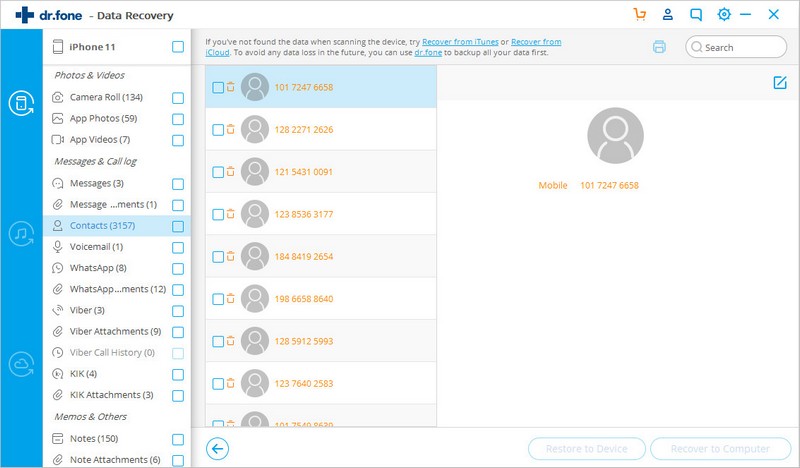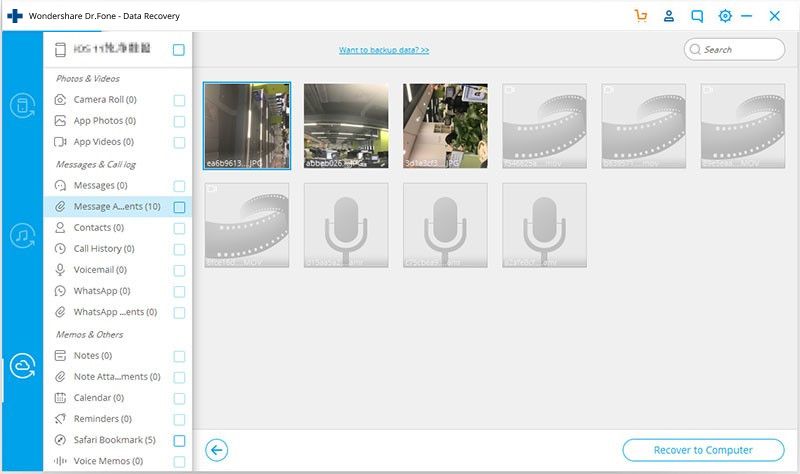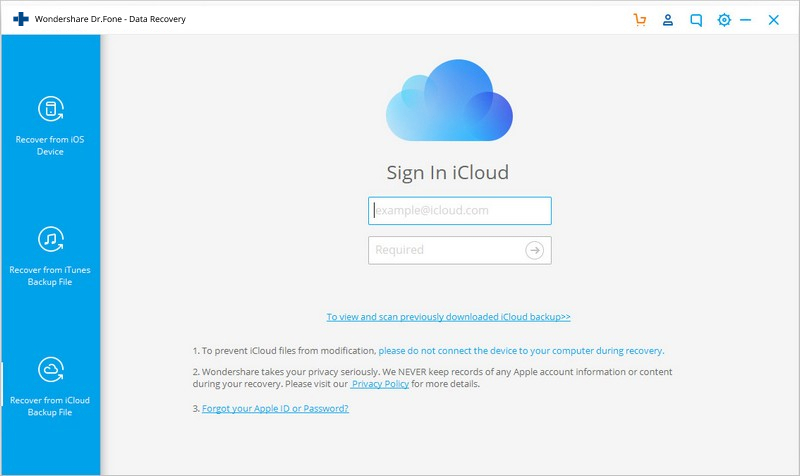 Home >
Home >Summary:Lost important data on your iPhone after iOS 14 update? Deleted contacts, messages, SMS, photos or notes on iPhone 12/iPhone 11 in iOS 14?Please do not be bothered by these problem. Here you’ll find three easy methods to restore lost data after iOS 10 update from iCloud, iTunes, iOS device on Mac or Windows computer with ease.
For an Apple fans, they may own an iPhone, iPad and Macbook at the same time.When the latest system released, many people update to the latest version at first,to reflecting and exploring the latest operating system.Now,the iOS 14 allow installed,recentlly,many iPhone users upgrade the iPhone 11/XS/XR/X/8 to iOS 13/iOS 14,but some of them facing data lossing.Once iPhone data deleted or lost after iOS update,for Macbook and iPhone users,how to recover deleted data from iPhone with iOS 14 update on Mac? In this article, we will teach you three easy ways to recover lost, deleted, formatted, wiped files from iOS 14 devices on Mac.
.png)
When the iOS 14 be released and many Apple fans upgrade their iPhone, iPad, iPod touch from iOS 12, iOS 13 to iOS 14 without hesitation,because the wrong operation, or upgrade the jailbroken iPhone devices to iOS 14 without iTunes firware update cause data loss, for all kinds of reasons may cause iPhone data loss after iOS 13, iOS 14 update.However,no matter your iPhone is jailbroken or not,we strongly recommended that you should back up iPhone data before iOS 14 upgrade with/without firware update,in order to prevent all important data stored in your iPhone be erased after iOS 14 update failure.Unfortunately,if you haven't make iPhone backup and data erased due to iOS 14 upgrade failure,how can you recover deleted data from iPhone in iOS 14?This article mainly teach you three ways to retrieve lost iPhone data when update to iOS 14.
Here we recommend you use this iOS 14 Data Recovery for Mac/Windows program to scan and recover everything including text messages, contacts, photos, videos, music, notes, call logs, SMS, Apps data, etc from iPhone 11/XS/XR/X/8/7/6S after iOS 14 update on Macbook or Windows computer in three recovery modes.
Lost iPhone data after iOS 14 update or iOS 14 jailbreak? Don’t worry, iOS Data Recovery provides you three ways to recover lost data from iPhone, iPad and iPod after iOS 14 upgrade or jailbreak: scan and recover iPhone files on Mac directly without backup; restore iPhone data by extracting iTunes backup; and restore iPhone contents from iCloud backup file on Macbook with Mac OS X 10.11(El Captain), 10.10(Yosemite), 10.9(Mavericks), 10.8, 10.7, or 10.6,as well as Windows Computer with Windows 10/8.1/8/7/Vista/XP. The iOS 14 Data Recovery can help you recover lost pictures, videos, notes, contacts, text messages,calendar, call logs, WhatsApp messages and more from iPhone, iPad, iPod in iOS 14, iOS 13, iOS 12 successfully.In additonal,if your iPhone stuck in recovery mode, Apple logo, iTunes logo screen or DFU mode after failing to update to iOS 14,the iOS 14 System Recovery program can help you fix iOS system turn to normal and get your iPhone out of recovery mode without data lossing.
.png)
.png)
iOS Data Recovery Works For Different Situations:
Three Ways to recover lost iPhone data after iOS 14 Update on Mac via iOS 14 Data Recovery for Mac Program,in this use guide we teach you how to recover lost or deleted data from iOS 14 devices on Mac,if you use Windows computer,you also can download the iOS 14 Data Recovery for Windows and follow the same steps to retrieve lost data from iPhone,iPad,iPod with iOS 14, iOS 13, iOS 12 easily.
| Part 1: Recover from iOS |
| Part 2: Recover from iCloud |
| Part 3: Recover from iTunes |
Step 1. Connect iOS Device with Computer
Use the USB cable that comes with your iOS device to connect your iPhone, iPad or iPod touch, to your computer. Then launch Dr.Fone on your computer and choose "Data Recovery".
.jpg)
Once the program detects your device, it will show you the window as follows.
.jpg)
Tips: Before running Dr.Fone, you're supposed to download the latest version of iTunes. To avoid the automatically sync, don't launch iTunes when running Dr.Fone. I suggest you to disable the automatical syncing in iTunes beforehand: launch iTunes > Preferences > Devices, check “Prevent iPods, iPhones, and iPads from syncing automatically”.
Step 2. Scan Your Device for Lost Data on It
Simply click the "Start Scan" button to let this program scan your iPhone, iPad or iPod touch to scan for deleted or lost data. The scanning g process may last a few minutes, depending on the amount of data on your device. During the scanning process, if you see that the data you're looking for is there, then you can click the "Pause" button to stop the process.
.jpg)
Step 3. Preview and Recover the Scanned Data
The scan will take you some time. Once it's completed, you can see a scan result generated by the program. Data both lost and existing on your device are displayed in categories. To filter out the deleted data on your iOS device, you can swipe the option "Only display the deleted items" to ON. By clicking the file type in the left side, you can preview the found data. And you can see there is a search box on the top right of the window. You can search for a specific file by typing a keyword in the search box. Then save the data to your computer or your device by clicking the recovery button.

Tips: About recovering data
When you find the data you need, just put the check mark in front of the box to select them. After then, click the "Recover" button at the bottom right of the window. By default, the recovered data will be saved to your computer. As for text messages, iMessage, contacts, or notes, when you click Recover, a pop-up will ask you to "Recover to Computer" or "Recover to Device". If you want to put these messages back to your iOS device, click "Recover to Device".
Step 1. Choose Recovery Mode
After running Dr.Fone, choose "Data Recovery" and click on it.
.jpg)
Then choose "Recover iOS Data".
.jpg)
After that, you can see there options for you to do data recovery. Choose "Recover from iCloud Backup Files". Then you'll see the window below. Enter your iCloud account and password to login. Dr.Fone takes your privacy seriously. We never keep a record of any your Apple account info or content at any time during your sessions.
.jpg)
Step 2. Download iCloud Backup File
When you logged into iCloud, the program can find all iCloud backup files in your account. Choose the one where you're going to recover data and click on the "Download" button.
.jpg)
And then in the pop-up, you can choose the type of files you would like to download. This will reduce the time of downloading the iCloud backup file. After that, you can scan the iCloud content now. Click on the "Next" button to start downloading. It will take you some time. Just wait for a moment.
.jpg)
Step 3. Preview and Recover Data from iCloud Backup File
The scan will be complete in a few minutes. Once it stops, you can preview almost all data in your iCloud backup file, like contacts, messages, photos, and more. Check them one by one and tick the item you want. Then click on the "Recover to Computer" or "Recover to your device" button to save them on your computer or your device with one click.
Now contacts, messages and notes can be directly recovered to your iOS device if your iPhone, iPad or iPod touch is connected with your computer with a USB cable during the recovery process.

Tips: Directly preview and recover data from downloaded iCloud backup files
If you have downloaded iCloud backup files previously, you don't need to sign in and get off the iCloud backup file again. Click "To preview and scan previously downloaded iCloud backup file" under the account sign-in entrance.

Then you can see all downloaded iCloud backup files displayed in a list. You can choose any of them to extract the content. All these downloaded backup files are located on your own computer. If you don't need them any more, you can click on the trash icon beside the scan button to delete them completely.
.jpg)
Step 1. Choose Recovery Mode
Launch Dr.Fone and click "Data Recovery".
.jpg)
Then choose "Recover iOS Data".
.jpg)
You can see three options on the side here. Choose "Recover from iTunes Backup File". After then, the iTunes backup recovery tool will detect all iTunes backup files on this computer and display them in the window. You can confirm which one is the one you need according to the date it has been created.
.jpg)
Step 2. Scan Data from iTunes Backup File
Choose the iTunes backup file that contains the data you want to recover and click "Start Scan". It will take a few minutes to extract all data from the iTunes backup file. Be patient.
.jpg)
Step 3. Preview and Recover Data from iTunes Backup
After a few seconds, all data in the backup file will be extracted and displayed in categories. You can preview them one by one before recovery. Then you can selectively mark and recover those you want by pressing the "Recover" button at the bottom. Now contacts, notes and messages can be directly recovered to your iOS device if you keep your iOS device connected with your computer via a USB cable during the recovery process.
Tips: you can see there is a search box in the result window. From there, you can type in the name of a file to search for it.
.jpg)
Tips: What if your iTunes backup file is located somewhere else?
When your iTunes backup file comes from somewhere, such as moved from another computer with a USB drive, how can you preview and get the content from it? There is a way. When you are at the first step, click "Select" under the list of iTunes backup files, and you can flexibly choose the iTunes backup file no matter where you place it.
.jpg)
Then in the pop-up window, preview and target your iTunes backup file. Then click "Start Scan" and you can move on with the step 2 above. It's pretty useful feature.
.jpg)
How to Recover Deleted Text Messages from iPhone
How to Recover Data from jailbroken iPhone
How to Transfer Data from iPhone to new iPhone
How to Get iPhone Out of Recovery Mode after iOS 10 Update